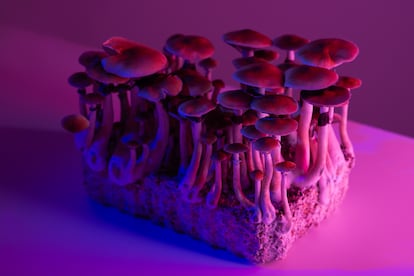The sacred drugs of antiquity: Fact and fiction
A new book explores the relationship between mythology and ritualistic use of hallucinogens in ancient history

One of the most fascinating aspects of ancient civilizations is the artistic and religious manifestation of their consumption of mind-bending natural substances. In the 1970s, historian Carl A. P. Ruck, mycologist R. Gordon Wasson and others coined a term to designate psychoactive substances used to produce visionary experiences in spiritual rituals – entheogens. The term is derived from two ancient Greek words: entheos, which translates as “full of the god, inspired, possessed,” and genesthai, which means “to come into being.” Together with Swiss chemist Albert Hofmann, the first to synthesize LSD, they wrote The Road to Eleusis, a controversial book that proposed the ritual use of ergot, a fungus with hallucinogenic properties, as a way of understanding the secretive Mysteries conducted at Eleusis in Greece for nearly two millennia. It wasn’t a new idea – other anthropologists and religious historians from renowned universities in Cambridge, Vienna and Chicago had proposed consuming the so-called “plants of the gods” to probe the myths, images and ancestral stories of ancient peoples.
While it was generally accepted that prehistoric peoples used psychoactive substances to induce visions, trances and ecstatic experiences, scholars found it hard to acknowledge that the Roman and Greek founders of Western civilization also had myths and rites full of references to these sacred plants. But when it came to the classical world, perhaps a deep-rooted Eurocentric bias hampered the objective application of the historiographic and anthropological approaches used to study “other peoples.” This bias seems to persist even today despite excellent books like Las drogas sagradas en la Antigüedad (or, The Sacred Drugs of Antiquity) by Carlos G. Wagner, which seek to dispel such outdated attitudes.
Wagner’s book is the culmination of 40 years of research that began in Phoenicia (an ancient civilization in the Levant region of the eastern Mediterranean), extended to the Greco-Roman world, and then to Egypt and the Ancient Orient. It is a comprehensive historical and cultural journey through the ancient world, from the dawn of the river valley civilizations to the symbiosis of Christianity with Greco-Latin cultural structures. Wagner’s book uses archaeobotanical accounts combined with literary and iconographic sources to examine entheogenic substance use in the art and religious rituals of various societies.
Wagner’s methodical and objective study of entheogens in antiquity provides substantial evidence of their use. Readers should not expect a New Age treatise on drug-based religious naturalism, or an anachronistic apology, or an all-encompassing and simplistic explanation for every mystery of antiquity, which characterize many books about entheogens. However, he does not shy away from controversial issues such as shamanism and other anthropological labels like thaumaturges (miracle workers) and medicine-men. Nor does he discount the notion that drugs may have inspired artistic creation and religious intuition since prehistoric times.
Such a study requires geographical and historical comparisons: East versus West, prehistory versus antiquity. It is surprising to read in Wagner’s book that great works like Gilgamesh and Homer’s epic poems may allude to ethnobotany and the manifestation of sacred botanical, oracular, shamanic or visionary symbology in art. One begins to wonder about the entheogenic backdrop of the hero’s battles with monsters like Medusa and Humbaba, or the references to magical herbs in Greek, Germanic and Celtic myths, not to mention the ones in Indo-Iranian religions. Wagner systematically tackles classic questions about Eleusis and Pythia, the Oracle of Delphi, and gives his readers a balanced assessment of what is known and what remains in the realm of hypothesis. He also includes a long discussion of Dionysian religion and its use of trance-inducing intoxicants, and compares it to the worship of other ancient nature gods of fruitfulness and vegetation.
Carlos Wagner has written an exciting book that synthesizes the current body of knowledge about the role of psychoactive substances, and also presents insights from neuroscience on how they affect the mind and body. The use of vision-inducing substances in spiritual rituals officiated by priestly elites enabled them to maintain their own power and prestige through stories, rituals and images. The myths, visions, sorceries, oracles and trances that persisted over four millennia can and should be viewed in the light of mythical plants like ambrosia, soma and haoma, and real ones like hellebore, dogbane, cannabis and poppy.
Sign up for our weekly newsletter to get more English-language news coverage from EL PAÍS USA Edition
Tu suscripción se está usando en otro dispositivo
¿Quieres añadir otro usuario a tu suscripción?
Si continúas leyendo en este dispositivo, no se podrá leer en el otro.
FlechaTu suscripción se está usando en otro dispositivo y solo puedes acceder a EL PAÍS desde un dispositivo a la vez.
Si quieres compartir tu cuenta, cambia tu suscripción a la modalidad Premium, así podrás añadir otro usuario. Cada uno accederá con su propia cuenta de email, lo que os permitirá personalizar vuestra experiencia en EL PAÍS.
¿Tienes una suscripción de empresa? Accede aquí para contratar más cuentas.
En el caso de no saber quién está usando tu cuenta, te recomendamos cambiar tu contraseña aquí.
Si decides continuar compartiendo tu cuenta, este mensaje se mostrará en tu dispositivo y en el de la otra persona que está usando tu cuenta de forma indefinida, afectando a tu experiencia de lectura. Puedes consultar aquí los términos y condiciones de la suscripción digital.
More information
Archived In
Últimas noticias
Most viewed
- Reinhard Genzel, Nobel laureate in physics: ‘One-minute videos will never give you the truth’
- Oona Chaplin: ‘I told James Cameron that I was living in a treehouse and starting a permaculture project with a friend’
- Pablo Escobar’s hippos: A serious environmental problem, 40 years on
- Why we lost the habit of sleeping in two segments and how that changed our sense of time
- Charles Dubouloz, mountaineering star, retires at 36 with a farewell tour inspired by Walter Bonatti










































